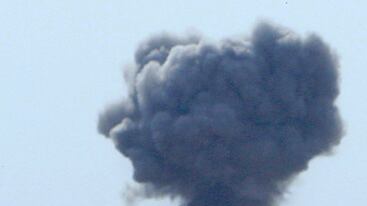
You’d need a slightly robotic view of human beings to believe this, but let’s say Hamas’ acts of terror, from suicide bombing to indiscriminate missile attacks, are the pure expression of a closed circle of jihadists, whose fanatic, intractable views are more or less conveyed by the organization’s charter: that the “land of Palestine is an Islamic Waqf [trust] consecrated for future Moslem generations until Judgment Day,” that Islam must “obliterate Israel,” and “all initiatives, proposals and international conferences are all a waste of time and vain endeavors.”
The carnage of Operation Cast Lead helps Hamas make its case—not only in Gaza, but across the West Bank.
Think of Hamas’ message as code—as the Darwinist digerati say, a “meme”—that spreads and replicates itself under given conditions. Suppose that no peace process can survive its triumph, and that not only Israelis, but West Bank leaders and professionals, moderate pro-Western Arab regimes, Americans and Europeans—all advocates of civil society—have an interest in seeing it defeated. How to fight it? Is Israel’s attack in Gaza, Operation Cast Lead, a kind of awful therapy?
Let’s leave aside for the moment whether Israeli settlement organizations express a corresponding fanaticism, or whether Israeli forces have ever committed acts that might qualify as terror, killing Palestinians indiscriminately (or accepting random “collateral” deaths), or whether people who were once terrorists, or actively tolerated terrorism, from Yasser Arafat to Yitzhak Shamir, might eventually be transformed into responsible political figures. No, let’s default to an extreme Machiavellianism, subordinate being loved to being feared, and entertain the idea that Israel should obliterate Hamas before Hamas obliterates Israel. Would we not first ask under what conditions the Hamas meme seems to have spread?
Twenty years ago, during the first intifada, Hamas was a miniscule Islamist organization, preaching a vague jihadism and just beginning to engage in suicide bombing and kidnapping. The vast majority of Palestinians were insisting on national representation by the Palestine Liberation Organization, which had begun angling for a two-state solution. Palestinians in the territories militantly resisted the occupation, but tens of thousands still worked on Israeli construction sites, and their mass demonstrations were not, on the whole, lethal: Most young men and women threw rocks and the odd Molotov cocktail at heavily armed soldiers and tanks. Defense Minister Yitzhak Rabin, afraid that a show of weakness would encourage resistance, adopted the “iron fist” policy of repressing the uprising, ordering his troops to “break the bones” of demonstrators—an order some soldiers took literally. Hamas stayed underground. As the intifada wound-down, Israeli-Palestinian dialogue groups flourished.
The Oslo process put Hamas into nearly total eclipse. Under Israeli pressure, Arafat’s Palestine Authority imprisoned Hamas activists. Israel, for its part, began to engage in targeted assassination of Hamas leaders, especially in Gaza. Yet Hamas was never wiped out because, throughout the Oslo process, neither side had any idea where peacemaking was leading. Jewish settlements never stopped; in fact, the number of settlers doubled, and annexationist activities in Jerusalem redoubled. The schools of the PA continued to glorify armed struggle.
In Gaza, where the Israel Defense Forces’ defense of Jewish settlements from periodic attacks trumped everything else, there were often border closings, and per capita income of Gazans plunged to about half of what it had been in the early 1990s. Fatah leaders of the PA enriched themselves, often claiming monopolies through their “ministries” of food and building commodities. Finally, in 2000, a new intifada erupted. Ariel Sharon tried another iron fist, which he called Operation Defensive Shield. He belittled the newly elected Palestinian president, Mahmoud Abbas, deeming him too weak to govern, while more and more Palestinians saw Fatah as Quislings. By the winter of 2006—after Sharon was forced to evacuate Gaza, much as Rabin had been forced to recognize the PLO—Hamas was strong enough to eke out a victory in PA elections. Hamas leaders even became culture heroes to Arab citizens of Israel who were increasingly frustrated by the exclusionary way so many Israelis defined the Jewish state.
This historical sketch is seriously incomplete, but some patterns are clear. The Hamas meme spread especially when Israelis attacked in Palestinian towns to “reestablish deterrence.” The idea that the disproportionate power of Israel’s occupation was ever doubted, or that Hamas acts of “martyrdom” came because its youth were simply not afraid enough of Jews, rests on the kind of primitive psychology you get from combat generals, neocons, and battered children.
Actually, Israel’s expansive power has always been a part of the Hamas message: The Hamas charter continues, “After Palestine, the Zionists aspire to expand from the Nile to the Euphrates.” And how could Israelis seriously expect ordinary Palestinians in their towns to turn off any Hamas insurgency just because they were getting battered?
Hamas ideology spread, moreover, when Israel insisted that the occupied territory of the West Bank was actually “disputed,” or tried to dissociate its evacuation from Gaza from what it was doing in the West Bank. Hamas influence spread when circles upon circles of grieving youth fought out of rage and survivors’ guilt. It spread when settlers seemed able to push Palestinians who would otherwise support a two-state solution into calls for steadfastness; or when jihadists were themselves able to push Israelis, who are increasingly skeptical of the settlements, into calls for national solidarity in the face of “existential threats.”
Hamas ideology spread, especially, when Israel sealed the Gaza border in a vain effort to starve the place of Hamas influence. It spread when Palestinian economic life seemed futile, or inevitably corrupt—when a fight to the finish seemed the only chance at a meaningful life. Why would Gazans feel beholden to Hamas’ tunnels if they had an open border, relief from grinding poverty, and business opportunities with West Bank partners?
Make no mistake, even under international law, Israel has the right to respond to missiles on Sderot and other southern towns. And if Israeli forces could wipe out Hamas in a great, terrible blow, killing only people set to kill Israelis, one could hardly blame the IDF for defending Israeli lives. A ground attack has just begun, but nobody in their right mind thinks this will end as a surgical strike, which will excise the whole of the Hamas leadership, and not utterly destroy many neighborhoods; already, much of Gaza city is without power; to kill Hamas extremist Nizar Rayyan, a bomb killed his four wives and nine of his children. It is most likely that Cast Lead will end in a monitored cease-fire, and that Israel will be satisfied to have made what one Sderot resident called “a statement.” Unfortunately, this statement helps Hamas, or its successor, make its case—not only in Gaza, but across the West Bank, and among Israeli Arabs as well.
The point is, the rise of Hamas is a cautionary tale about trying to do quickly with military force what needs to be done over a generation with reciprocity. All along, Israel might have made a strong statement of a different kind. It might have endorsed the obvious features of a two-state solution, like the ones worked out with President Clinton just before he left office in 2001. It might have helped strengthen the Palestinians' immunity to Hamas ideology, creating a stronger civil society, new businesses, new schools, new Palestinian cooperation with international peace-keepers and investors. It might have meanwhile announced, say, that it can know the precise location from which each Hamas missile is launched, and that it would bomb that location exactly ten minutes after each launch, giving surrounding citizens a chance to flee—and creating a mounting incentive for civilians to resist Hamas cadres using their homes as cover. One can think of any number of creative ideas that project strength, decency, and hope. This is not, well, rocket science.
Bernard Avishai splits his time between Jerusalem and New Hampshire. He is the author, most recently, of The Hebrew Republic: How Secular Democracy and Global Enterprise Will Bring Israel Peace at Last (Harcourt). A former editor of the Harvard Business Review, he writes for Harper’s and many other publications, and blogs at www.bernardavishai.com.





